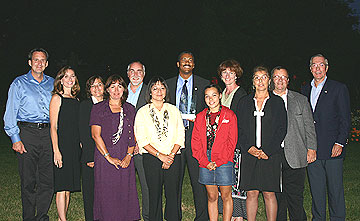 About ACHP
About ACHP ACHP News
National Historic
Preservation
Program
Working with
Section 106
Federal, State, & Tribal Programs
Training & Education
Publications
Search
Home
"Following the Smoke" Project Wins ACHP Chairman's Award
St. Paul, Minn.—"Following the Smoke," a U.S. Forest Service project conducted in conjunction with the Karuk Indigenous Basketweavers and other partners, received the Advisory Council on Historic Preservation's (ACHP) Chairman's Award for Federal Achievement in Historic Preservation on Aug. 4, 2004.
The award was presented by ACHP Chairman John L. Nau, III, at a recognition ceremony on Wednesday, Aug. 4, 2004, at the Governor's Residence in St. Paul, Minnesota. Gov. Timothy Pawlenty represents the Nation's governors as a member of the ACHP. He was appointed to the ACHP by President George W. Bush in August 2003.

From left to right: Governor and Mrs. Pawlenty; Kathy McCovey-Barger, Archeologist, Six Rivers National Forest; Deanna Marshall, Karuk Indigenous Basketweavers; Jeff Walter, Forest Supervisor, Six Rivers National Forest; Renee Stauffer, Karuk Indigenous Basketweavers; Randy Moore, Regional Forester, Eastern Region; Dori Marshall, Karuk Indigenous Basketweavers; Martha Ketelle, Assistant Director of Recreation and Heritage, U.S. Forest Service National Headquarters; Verna Reece, Karuk Tribe of California; Ken Wilson, State Archeologist and Tribal Liaison, Bureau of Land Management; and John Nau, ACHP Chairman. (ACHP staff photo)
"Following the Smoke" is a seven-year-old project to sustain and share with the public the full process of basketweaving, from gathering and creating the materials to the finished products. The project's name comes from the local Karuk, Yurok, and Hupa basketweavers' practice of combing areas after Forest Service-controlled burns to find beargrass shoots and other suitable natural materials for weaving.
Because the traditional vegetation necessary to create hand-crafted basketry grows best in forest areas that have experienced a fire, volunteers participate in preparing forest areas for controlled burns conducted by the Forest Service, thinning heavy fire fuel areas, and constructing fire breaks.
"Fire doesn't just enhance the basketry materials," basketweaver
Millie Black Graber said. "It's healthy for the forest."
Chairman Nau noted, "The staff of the Six Rivers National Forest,
the Karuk Indigenous Basketweavers, and their associates have combined
efforts to create a powerful positive example of how partnerships in preservation
can benefit individuals, local areas, and the Nation."
The project's benefits are cultural, educational, environmental, and economic. Volunteer Following the Smoke participants camp for a week with Native American basketweavers, helping collect, process, and weave the natural materials that have been used for millennia to create fine basketry.
The volunteers also participate in storytelling and other traditional activities, thereby learning about the relationship between healthy forests, cultural activities, and heritage preservation.
Under the project, more than 500 participants have volunteered an estimated 2,800 hours of work preparing landscapes for controlled burns, saving approximately $25,000 in taxpayer dollars.
"Following the Smoke" is one project in the larger U.S. Forest Service Passport in Time (PIT) program. PIT is a national program that gives volunteers the opportunity to participate in a wide-ranging selection of historic preservation and cultural resource projects.
The principal partners in Following the Smoke are the Six Rivers National Forest and the Karuk Indigenous Basketweavers. Others involved include the Karuk Tribe of California, California Department of Transportation, California State Office of the U.S. Bureau of Land Management, and the California State Preservation Office.
Accepting on behalf of the U.S. Forest Service were Jeff Walter, Forest Supervisor, and Kathy McCovey-Barger, Archeologist, both of the Six Rivers National Forest; Randy Moore, Regional Forester for the Eastern Region; and Martha Ketelle, Assistant Director of Recreation and Heritage, National Headquarters.
Receiving ACHP Partnership Commendations were Renee Stauffer, Deanna Marshall, and Dori Marshall, for the Karuk Indigenous Basketweavers; Verna Reece, for the Karuk Tribe of California; and Ken Wilson, for the California State Office of the U.S. Bureau of Land Management.
-----
An independent Federal agency, the ACHP promotes historic preservation nationally by providing a forum for influencing Federal activities, programs, and policies that affect historic properties, advising the President and Congress, advocating preservation policy, improving Federal preservation programs, protecting historic properties, and educating stakeholders and the public.
The Chairman's Award for Federal Achievement in Historic Preservation recognizes Federal projects, programs, initiatives, and policy leaders or career staff that make significant contributions to historic preservation in the Federal Government. Formal recognition by the ACHP's chairman celebrates Federal preservation successes and provides a means for the ACHP to honor and showcase Federal accomplishments and best practices.
Posted
August 5, 2004